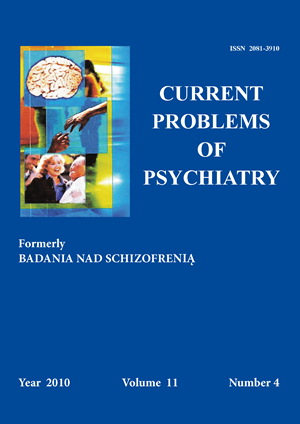The narcissistic features and eating disorders in male bodybuilders
Keywords:
eating disorders, gym, men, narcissismAbstract
The purpose of the study was to investigate the differences in personality traits and symptoms of eating disorders among men regularly practicing and non-practicing in the gym.
Examined group: There were examined 30 men, who exercise regularly at the gym (clinical group) and 30 men who do not exercise at the gym (control group). The average age of the respondents in both groups was 26 years.
City dwellers were 87% of male bodybuilders and 100% of people not exercising at the gym. In the clinical group: 60% of men had secondary education and 40% - higher. In the control group 17% of respondents had secondary education and 83% - higher. Coming from full family was reported by 73% of male exercisers, and 90% of people not exercising at the gym. Alcohol abuse was reported by 40% of bodybuilders and 23% of non-exercisers.
Methods: The study used The Survey by Zofia Stankiewicz, the Eating Disorder Inventory (EDI) by D.M. Garner, M.P. Olmsted and J. Polivy and the Narcissism Inventory (N) by F. Deneke, B. Hilgenstock and R. Müller, in Polish study by Januszewski.
Results: Men who exercise regularly at the gym scored significantly lower scores in comparison with non-exercising men in the range of EDI scales: Body dissatisfaction and Ineffectiveness, and significantly higher scores in Perfectionism scale of EDI Inventory and in all scales of factors: “Classic Narcissistic Self "and "Ideal Self” of the Narcissism Inventory.
Conclusions: 1. Male bodybuilders feel strong pressure to succeed, gain exceptional achievements in their lives. 2. Male bodybuilders are characterized, in comparison with nonathletes, by significantly more severe greatness, the need to exalt and exaggerate themselves, a sense of special uniqueness concerning physical attractiveness and the need for attracting attention of others. 3. Men who practice regularly at the gym, more often than non-exercisers, treat other people instrumentally, manipulate them to meet their own needs and consider others as superficial, threatening, devoid of ideals, irresponsible, unreliable and disappointing. 4. In a situation of stress and problems, men who practice regularly at the gym, more often than those not exercising, use the defence mechanism of denial and strategies focused on emotions. 5. Male bodybuilders are characterized by severe narcissism and perfectionism. Intense exercises can be a way of drawing attention to themselves, building a sense of their own uniqueness, originality and physical attractiveness, and a form of escape from stress and problems.6. Intensive exercising at the gym and excessive concentration on own figure in men is not connected with disturbed eating behaviours, as it is among women, but with severe perfectionism and narcissistic personality features.
References
1. Segura-García C., Ammendolia A., Procopio L., Papaianni M.C., Sinopoli F., Bianco C., De Fazio P., Capranica L. Body uneasiness, eating disorders, and muscle dysmorphia in individuals who overexercise. J. Strength Cond. Res., 2010; 24(11): 3098-3104.
2. Davis C., Scott-Robertson L. A psychological comparison of females with anorexia nervosa and competitive male bodybuilders: body shape ideals in the extreme. Eat. Behav., 2000; 1(1): 33-46.
3. Pope H.G., Gruber J.A., Choi P., Olivardia R., Phillips K.A. Muscle dysmorphia: an underrecognized form of body dysmorphic disorder. Psychosomatics, 1997; 38: 548-57.
4. Pope C.G., Pope H.G., Menard W., Fay C., Olivardia R., Phillips K.A. Clinical features of muscle dysmorphia among males with body dysmorphic disorder. Body Image, 2005; 2: 395-400.
5. Pope H.G., Phillips K.A., Olivardia R. The Adonis complex: the secret crisis of male body obsession. New York; Free Press: 2000.
6. Olivardia R., Pope H.G., Hudson J.I. Muscle Dysmorphia in Male Weightlifters: A Case-Control Study. Am. J. Psychiatry, 2000; 157: 1291-1296.
7. Kanayama G., Barry S., Hudson J.I., Pope H.G. Jr. Body image and attitudes toward male roles in anabolic-androgenic steroid users. Am. J. Psychiatry, 2006; 163(4): 697-703.
8. Leit R.A., Gray J.J., Pope H.G. Jr. The media's representation of the ideal male body: a cause for muscle dysmorphia? Int. J. Eat. Disord., 2002; 31(3): 334-338.
9. Hartgens F., Kuipers H. Effects of androgenic-anabolic steroids in athletes. Sports Med., 2004; 34(8): 513-554.
10. Hokema F., Pietsch U.C., Führer D., Kaisers U. Anesthesia and bodybuilding. Anasthesiol Intensivmed Notfallmed Schmerzther, 2008; 43(5): 354-358.
11. Nottin S., Nguyen L.D., Terbah M., Obert P. Cardiovascular effects of androgenic anabolic steroids in male bodybuilders determined by tissue Doppler imaging. Am. J. Cardiol., 2006; 97(6): 912-915.
12. Kjelsas E., Augestad L.B. Gender, eating behavior, and personality characteristics in physically active students. Scand J Med Sci Sports 2004;14:258-68.
13. Hallsworth L, Wade T, Tiggemann M. Individual differ-ences in male body-image: an examination of self-objectification in recreational body builders. Br. J. Health Psychol., 2005; 10(Pt 3): 453-465.
14. Goldfield G.S., Blouin A.G., Woodside D.B. Body im-age, binge eating, and bulimia nervosa in male body-builders. Can. J. Psychiatry, 2006; 51(3): 160-168.
15. Gardner D.M., Olmsted M.P., Polivy J. The development and validation of a multidimensional Eating Disorder Inventory for anorexia nervosa and bulimia. Int. J. Eat. Disord., 1983; 2: 15-34.
16. Januszewski A. Kwestionariusz Narcyzmu. Wartość diagnostyczna w świetle wyników badań polskiej mło-dzieży. W: Oleś P. red., Wybrane zagadnienia z psychologii klinicznej i osobowości. Metody diagnostyczne w badaniach dzieci i młodzieży. Lublin; Towarzystwo Naukowe KUL: 2005, s. 153-196.
17. American Psychiatric Association. Diagnostic and Statistical Manual of Mental Disorders, 4th ed. (DSM-IV). American Psychiatric Association; Washington DC: 1994.
18. Drozdowski P. Wskazania do psychodynamicznej terapii zaburzeń odżywiania się. W: Bomba J., Józefik B. red., Leczenie anoreksji i bulimii psychicznej: co, kiedy, komu. Biblioteka Psychiatrii Polskiej; Kraków: 2003, s. 55-61.
19. Stankiewicz Z., Pawłowska B. Symptoms of eating dis-orders and narcissistic features in female athletes. Curr. Probl. Psychiatry, 2010; 11(3): 232-236.


